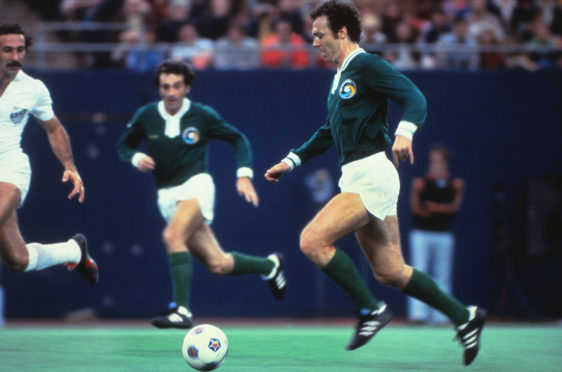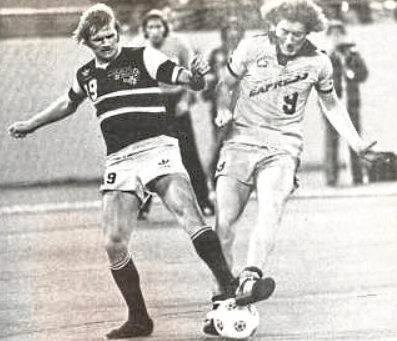
It’s 38 years since my football career nearly went to the dogs.
However, thanks to my old mate, Eric Gates, I was reborn in the USA.
On this day in 1978, I was lining up for Detroit Express in a game against Portland Timbers.
A 1-0 defeat wasn’t the best of starts at a new team, but I ended up having a fabulous four months in America.
Admittedly, my commitment to enjoying myself meant it wasn’t the most financially-rewarding spell, more of which later.
The story of this adventure across the Atlantic starts on the day before the FA Cup Final.
I was hoping to be on the bench for Ipswich Town against Arsenal.
I’d scored a few goals in the run-up to the Final, but Bobby Robson told me I hadn’t been picked for Wembley.
Mick Lambert was sub, leaving Eric Gates and me disappointed.
But Bobby had a consolation prize for me – I was off on loan to the North American Soccer League.
When Gatesey and me knew we weren’t playing, we went to Hackney dog track and I lost all my money.
I told Eric I was going to America straight after the Final and asked if I could borrow £40 to tide me over.
Fortunately, good mate that he is, he lent me the cash.
I watched Roger Osborne score to win us the cup and headed to the States the next morning.
I’d been set a challenge by Bobby Robson – to find the extra yard of pace that would make me a top player.
I arrived in New York and took a cab to Giants Stadium, where I watched my new team-mates taking on Franz Beckenbauer and the New York Cosmos.
As an 18-year-old, I was still learning the game, but we also had Trevor Francis in the team.
He was an established star and had already broken into the England side. He scored a bundle of goals for us.
The road trips were incredible. I was suddenly seeing places like Houston, Philadelphia, San Jose, Vancouver and Seattle.
There’s a topical element to my memories of a summer in America.
FIFA weren’t keen on the NASL because they frowned upon any tinkering with the rules.
Just in the past few days we’ve seen a temporary ruling that will allow up to five substitutions when football returns after the coronavirus crisis.
I can live with that, but I’m not giving any time to the suggestion of playing 30-minute halves.
That’s not on. Top-flight clubs have enough players to cope with competing for the usual 90 minutes.
Let’s not make a farce of the game.Back in 1978, the Americans allowed three substitutes, where we just had one in English football at that time.
They also had overtime and shoot-outs to stop any drawn matches.
There was a different points system and a line on the pitch that meant you couldn’t be offside more than 35 yards from goal.
In some ways, they were ahead of their time. We now accept multiple substitutions, and we’re used to three points for a win.
My experience of different rules helped make me a better player.
I became really good at taking on goalkeepers one-on-one, and I’m sure that was helped by the taking part in shoot-outs. You ran from 35 yards and had five seconds to take the ball towards the keeper and score.
The different offside rule also suited me. A lot of the defenders like to push up to the 35-yard mark, and I loved using my pace to get behind them.
When I came back to Ipswich Town, I hadn’t just gained one yard, I reckoned I was two yards quicker.
Bobby Robson got good reports about me and offered to double my wages to £110 a week. I refused that.
I was warned that I’d be out of the club if I didn’t start scoring goals.
I took my chances and got myself £300 a week and a £12,000 signing-on fee.
Mind you, I wasn’t so flush when I first got back from the States.
I flew home with Newcastle United goalkeeper Steve Hardwick and Ian Davies of Norwich City.
Steve had $32,000 to take home and Ian was carrying $29,000.
Me? I had 80 bucks in my pocket.
The exchange rate was two for one at the time, so at least I had enough to give Eric Gates his 40 quid back!

Enjoy the convenience of having The Sunday Post delivered as a digital ePaper straight to your smartphone, tablet or computer.
Subscribe for only £5.49 a month and enjoy all the benefits of the printed paper as a digital replica.
Subscribe